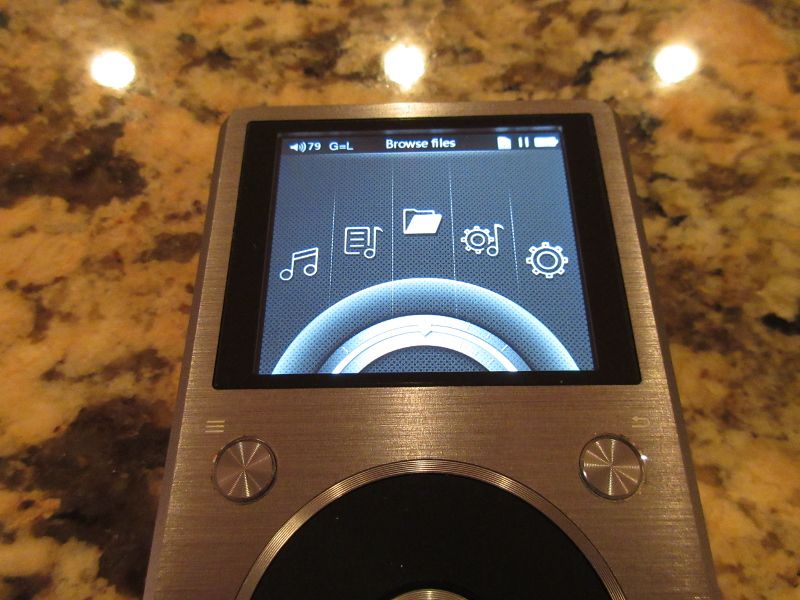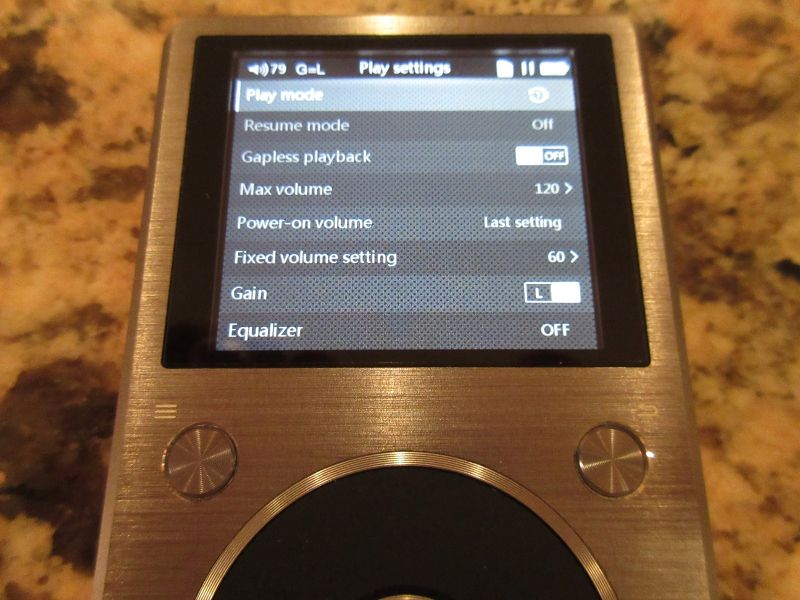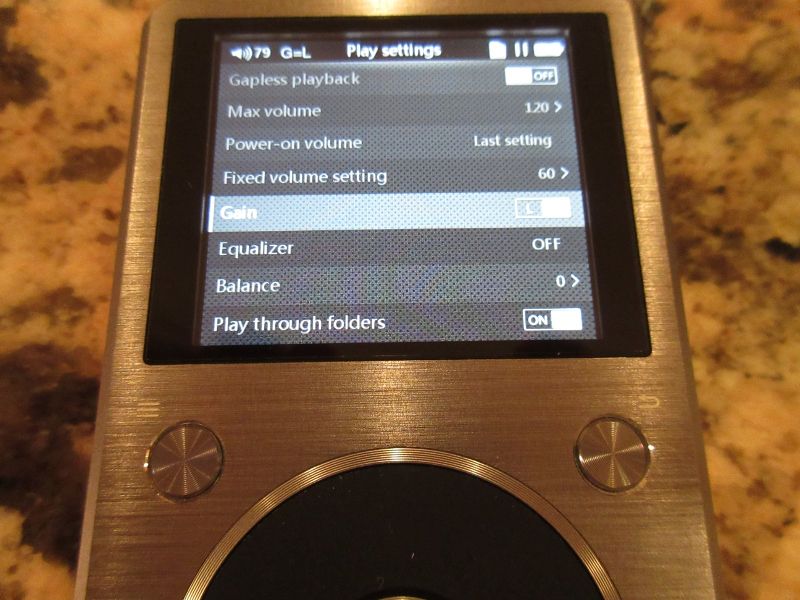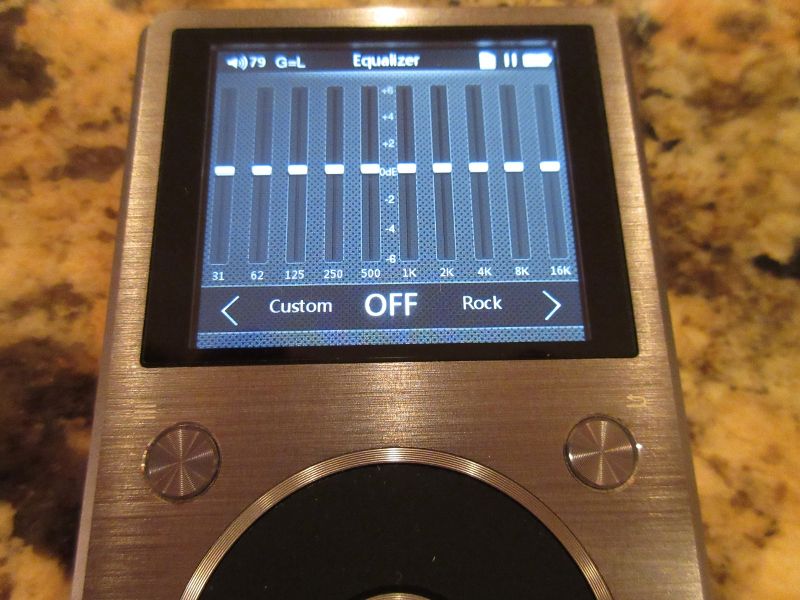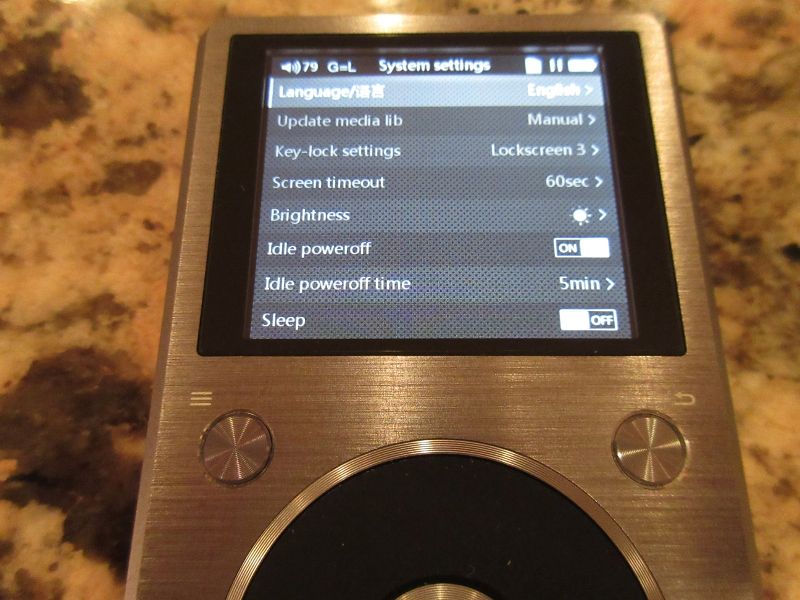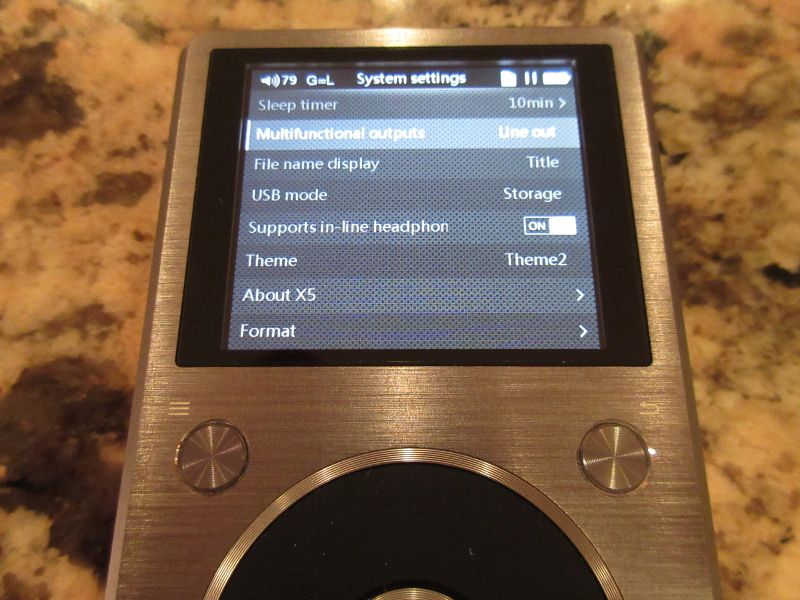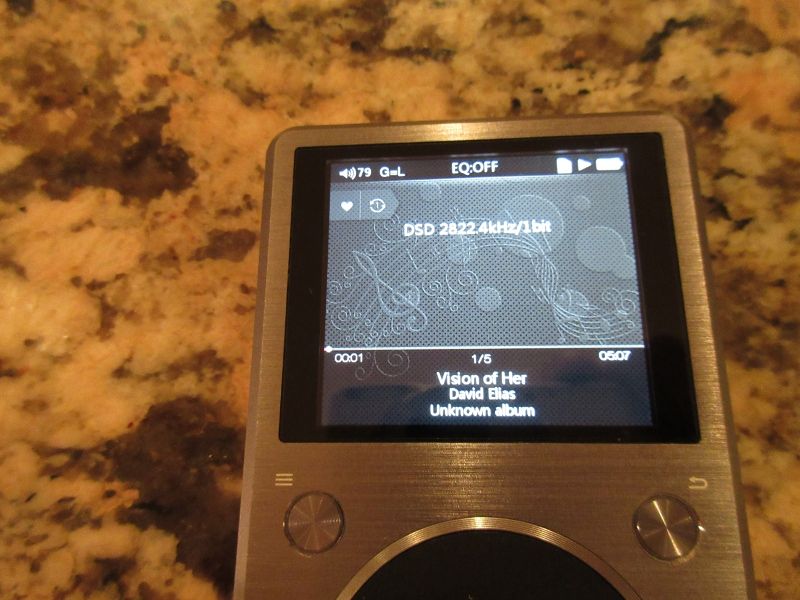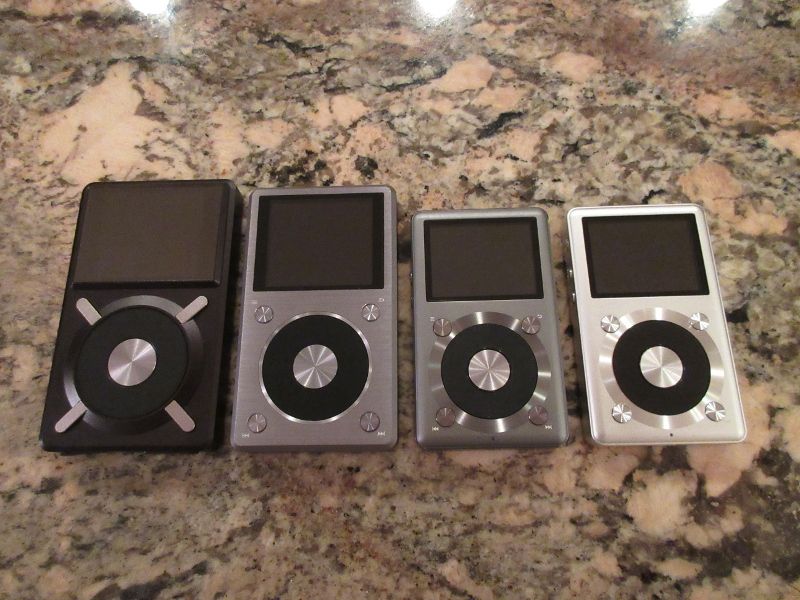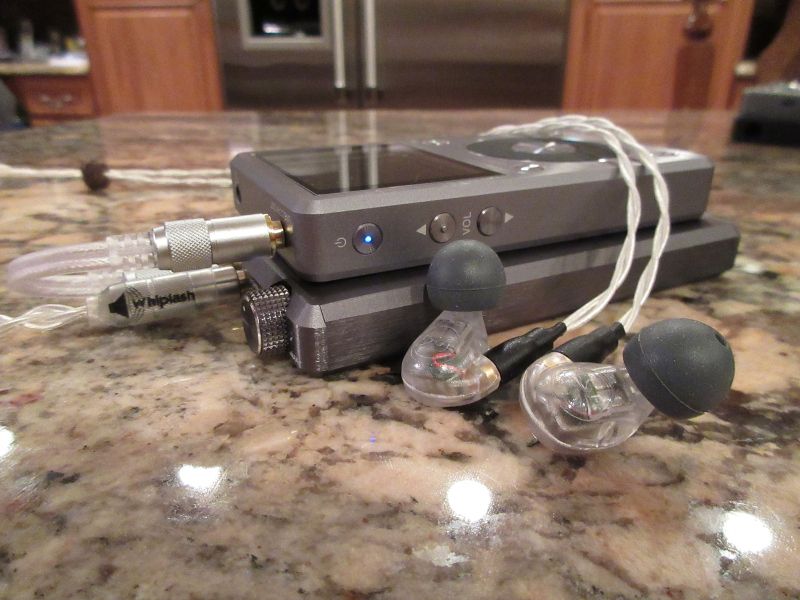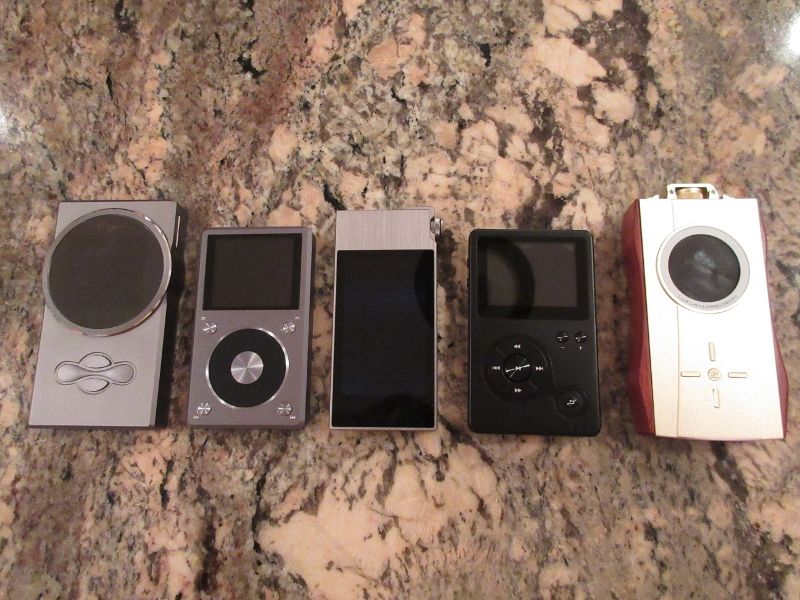This is a Review of FiiO X5 2nd gen (X5ii) Digital Audio Player (DAP). http://www.fiio.net/en/products/41 , also available on Amazon: http://www.amazon.com/dp/B00ZWAC25E/?tag=vectron00-20
With a consistent flow of new releases, I feel like we have been spoiled by FiiO and their quality audio products. I didn’t even realize it has been year and a half since the release of their original X5, and now I’m looking at their new X5ii flagship DAP released a few months after another impressive X3ii DAP update. What strikes me the most, FiiO continues to update a number of their previously released models (DAPs and amps) while keeping price in the same ballpark. And I’m not talking about a cosmetic refresh or a firmware update but actually a complete redesign. Perhaps it’s the way how they challenge themselves, trying to come up with a creative update without raising the cost. In my opinion, they do succeed every single time, with their latest X5ii being another perfect example of it!
At the same time this high pace of new releases sometime feels like smartphone industry where every six months to a year we are faced with choices to either stay with a current phone or to upgrade, and if you decide to upgrade - either going with a smaller or bigger screen model. I think a lot of FiiO fans will be facing a similar choice, either keeping their original X5 or upgrading to a “smaller” X3ii or a “bigger” X5ii, figuratively speaking. If you want the latest and the greatest new release, a decision is simple - go with X5ii without looking back. But for other loyal FiiO fans or new customers who are looking into different DAPs, I hope my review will provide some useful guidance to make your decision easier. FiiO is very active and generous in various audiophile communities, such as Head-fi, where a lot of reviews and impressions have been posted already. With my write up I hope to fill in some gaps and to offer a different perspective to compliment other available info.
Though the unit I received is pre-production review sample, the content of the packaging should be close to the final product which I'm sure will include a colorful outer sleeve on top of the box my unit came in. Keeping up with a tradition, X5ii arrived in a formally dressed black gift box setting with a nicely padded interior to ensure a secure transport of its content. I personally like such gift-box detail, actually adapted by a number of manufacturers, since it makes unboxing experience a little more special and a sturdy carton box is also a great storage.
Unboxing.
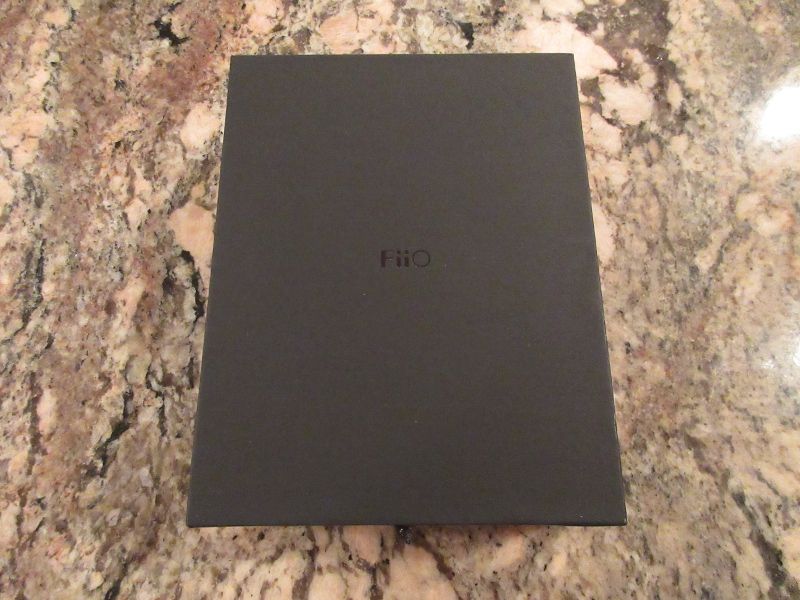
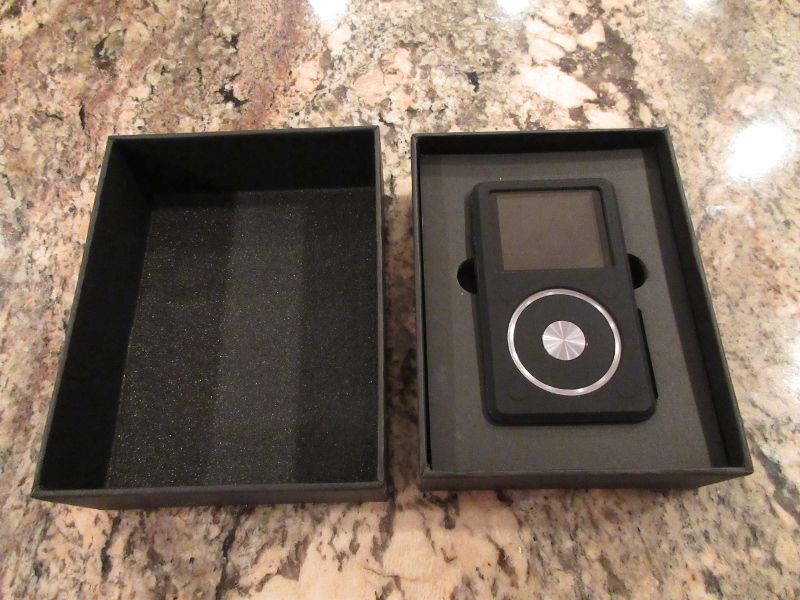
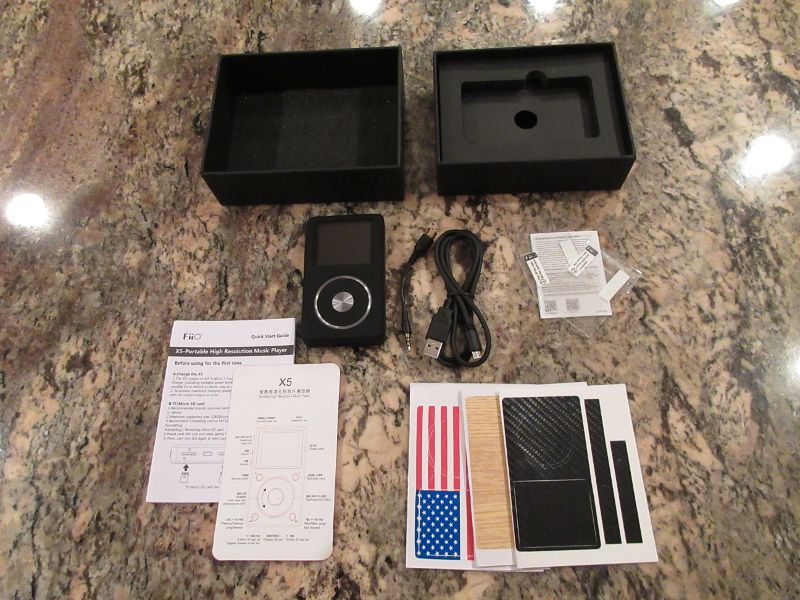
Already dressed in silicone skin and ready for action, after removing X5ii from a cutout of the foam insert tray, I accessed the accessories box and was able to explore the rest of the included goodies. No surprises were found here, just a familiar set of accessories consistent with their other models. You get a quick start guide and a separate flash card with a layout and explanation of hardware controls, extra 2 sets of screen protector in addition to the one which comes already pre-installed, a cover stickers for the front/back/sides if you decide to personalize your DAP further (includes US flag, wood, and carbon fiber themes), usb to micro-usb power/data cable, and a short Coax patch cable. I think a final production unit will also feature a flash card reader.
While a carbon fiber sticker doesn't look too bad, I’m not so sure about other two themes and would suggest in a future to include something alternative for the ladies. Brushed aluminum and carbon fiber finish is great for guys, but I would like to see FiiO making an effort to widen their sex appeal. Actually in my personal opinion, the brushed aluminum body finish is too cool to cover with anything permanent, except with an included silicone case. Screen protector is always a good idea to protect X5's gorgeous 2.4" HD IPS screen from scratches and smudges. As for usb cable, FiiO usually includes a quality one which also guarantees a fast 2A charging with an appropriate supply. The micro-usb connector is slim and has a nice lock grip, just another detail I want to bring up since with a few of my other usb charging cables I had to take silicone skin off in order to get a proper fit/connection. Coax cable is different from the original X5 since in X5ii LO and Coax 3.5mm ports are shared, thus you will find extra ring-contacts (TRRS style) on 3.5mm connector side.
Accessories.

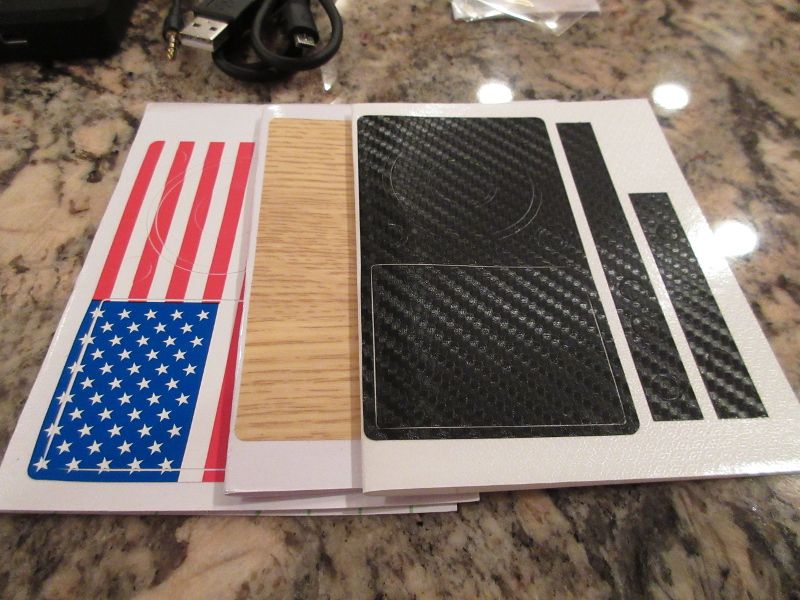
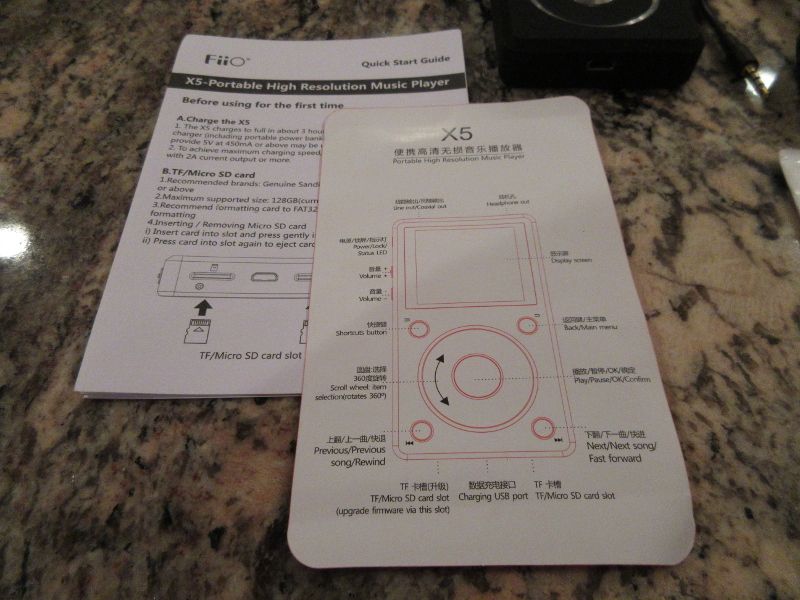
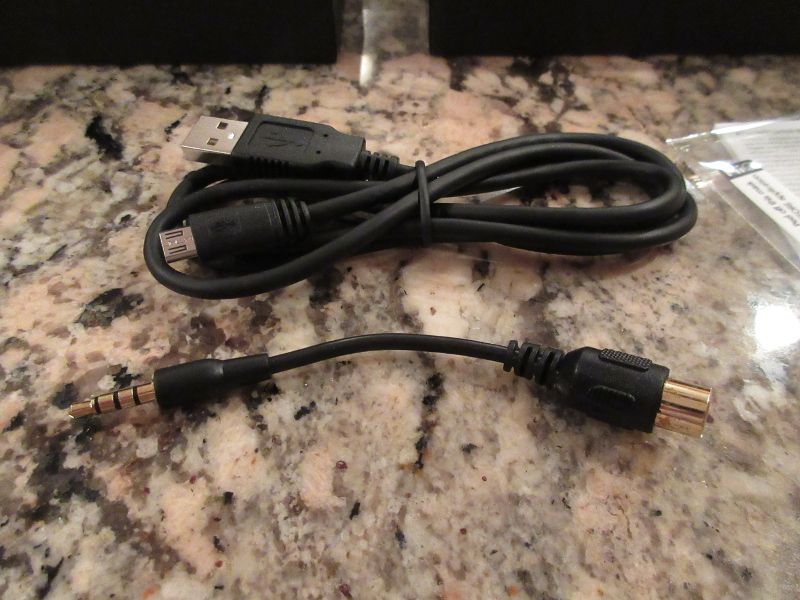
I usually don't spend too much time talking about silicone case, but still wanted to bring up a few important points. There is no surprise, silicone case gets static and becomes a lint magnet, but I still prefer it over any slippery plastic case because I like a secure grip. Another benefit, it protects your DAP from scratches and minor drops, creates extra friction when placed on a smooth surface, protects outside surface itself from scratches, and protects the shell from scratches when stacked with external amp rubber-banded together. The case has a perfect cutout for screen and navigation wheel, micro-usb port, a flap over LO/Coax port, and open HO port.
HO port opening is very useful in this case because FiiO flipped HO and LO ports in comparison to their other DAPs where left-most port used to be always for Headphone Output. We are creates of habit, and without a case and both ports exposed there is a very good chance that you will make an attempt to plug in your headphones into LO port to get a very unpleasant ear-full surprise, especially if you are a/b it with original X5 or X3ii. So even if you prefer to go naked without a case, use it for the first few weeks as training wheels until you get used to HO port being on the right side at the top.
Another interesting discovery I made even before turning the power on was a hole right in the middle of the power button cover. In this new X5ii model FiiO integrated a status multi-color LED right inside of the power button thus an explanation for a small opening in the case to view the light. Volume up button on a silicone case, just like with an actual DAP button, has a little id bump so you can identify volume+ control blindly in your pocket with a brush of a finger. Power button itself is flush mounted to avoid accidental pressing. The other 4 control buttons around navigation wheel are flush mounted as well and also nearly flat on the silicone case. It's useful if you have selected Lockscreen option that enables their control for track switching, and you no longer have to worry about accidentally pressing buttons in your pocket the way how it was with raised buttons in original X5. But at the same time, I would prefer buttons to be raised just a little bit like it was in X3ii which is the most ideal in my opinion.
Silicone case.
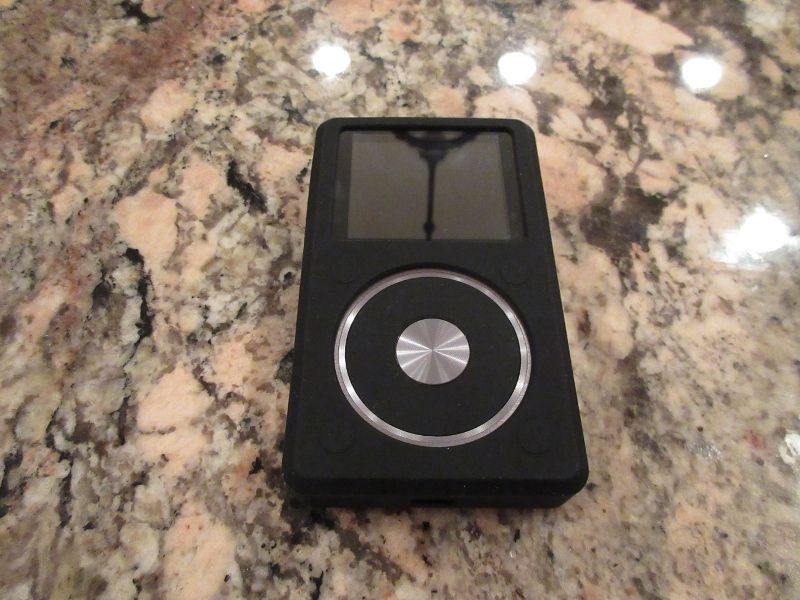
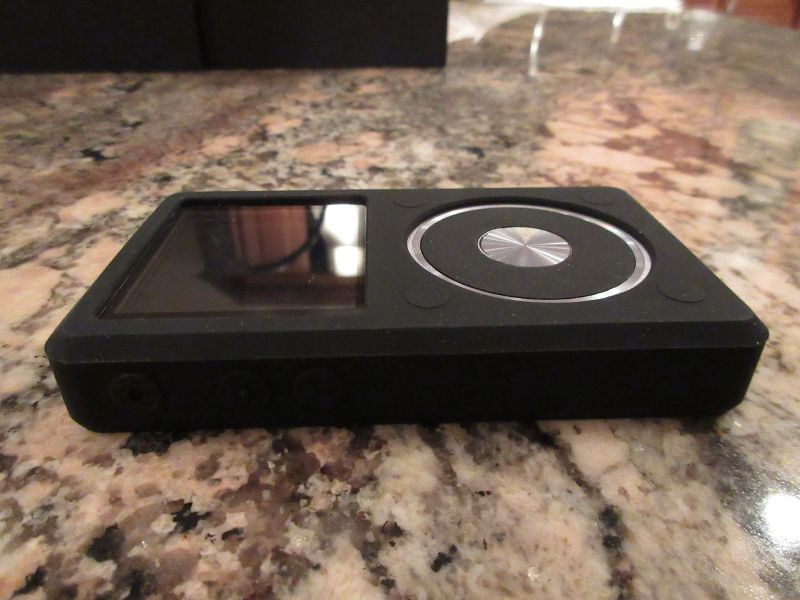
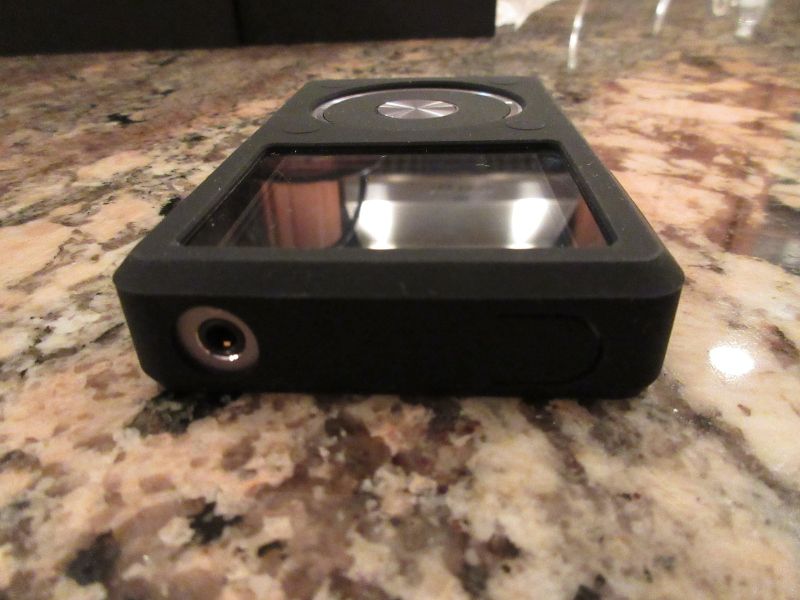
When it comes to the actual design, in my opinion X5ii is definitely a step forward in terms of a more compact footprint in comparison to the original X5. While keeping the thickness nearly the same, the length and the width got trimmed down and weight got reduced by nearly 30g. Similar to X3ii design, top of the unit has 3.5mm Headphone Output (HO) and a shared Line Out (LO) and Coax outputs. There is nothing on the right side, and left side is consistent with a top Power button (already discussed with a built-in status led) and volume up/down buttons. No longer will you find a reset pinhole, just need to press and hold power button for the same functionality. Consistent with the original X5 design, the bottom has 2 micro-SD card slots and micro-usb connector. You are also going to find 2 screws at the bottom if you dare to take X5ii apart, though be aware of voided warranty.
You will no longer find a dust cover rubber flaps over micro-SD slots similar to the original X5. If you carry your X5ii in a silicone case, it really doesn't matter since it will be covered and protected from dust already. I also believe it's not a big deal without a case with a card inside, like it is with any other DAP. But considering dual card slot and if you are not using a case and only have one card populated - it's not ideal for the other slot to be open while collecting the dust. Perhaps, get some dummy or super cheap micro-sd card from ebay just to use for the purpose of keeping a dust away.
The front of X5ii has 2.4" HD IPS screen at the top and a scrolling wheel with 4 control buttons around it and one button in the middle, a familiar layout carried over through all of the X-models (after the original X3). I know a lot of people will be curious about a scrolling wheel "evolution" since FiiO has been consistent with improvements from X5 to X1 and X3ii. Unfortunately, my review unit came from a first pre-production batch where FiiO made it clear this is not a final wheel version. It wasn't as wobbly as X5 wheel, but still had a loose movement without a click-feedback like implemented in X3ii. FiiO mentioned that final production units will have a scrolling wheel similar to X3ii which has been already confirmed by some users who got their hands on final production units. When it comes to my actual review unit, I wasn't as pleased with a wheel due to a light-touch turning by simply brushing against it. Unfortunately that happened a lot because control buttons were flushed with a surface and I had to hover over a surface with my finger to locate them. Even with a scrolling wheel mechanism such as the one used in X3ii, I personally think the layout of these buttons pushed away a little more from the wheel and the flush mounted design is a step back from X3ii where it was just perfect for one handed operation. X5ii is still feasible to use with one hand, but I just wish the beveled area and buttons around the wheel were similar to X3ii. Either way, if I get a chance to play with final production unit, I will come back and update my scrolling wheel impression.
Design details.
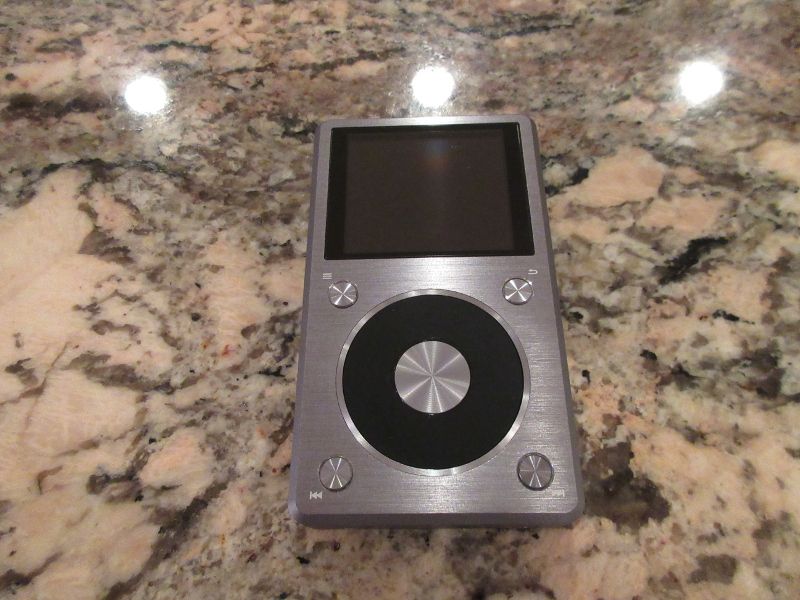

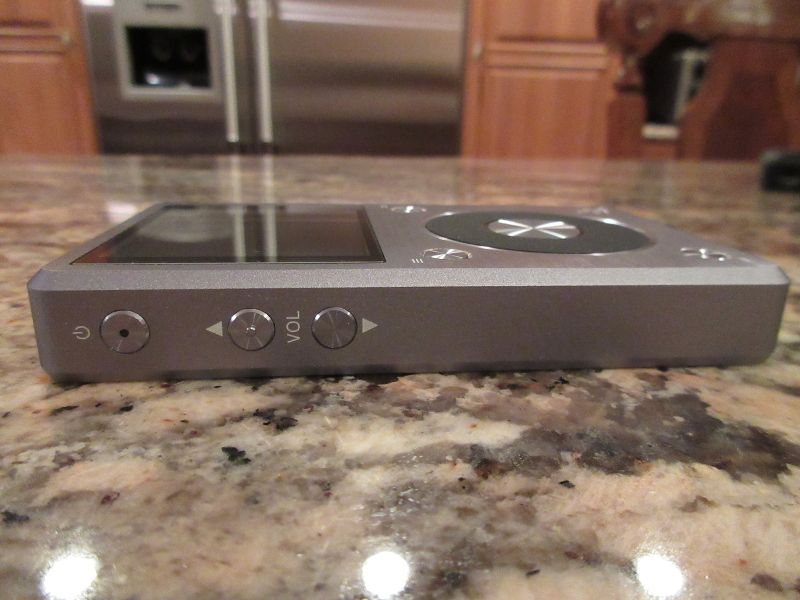
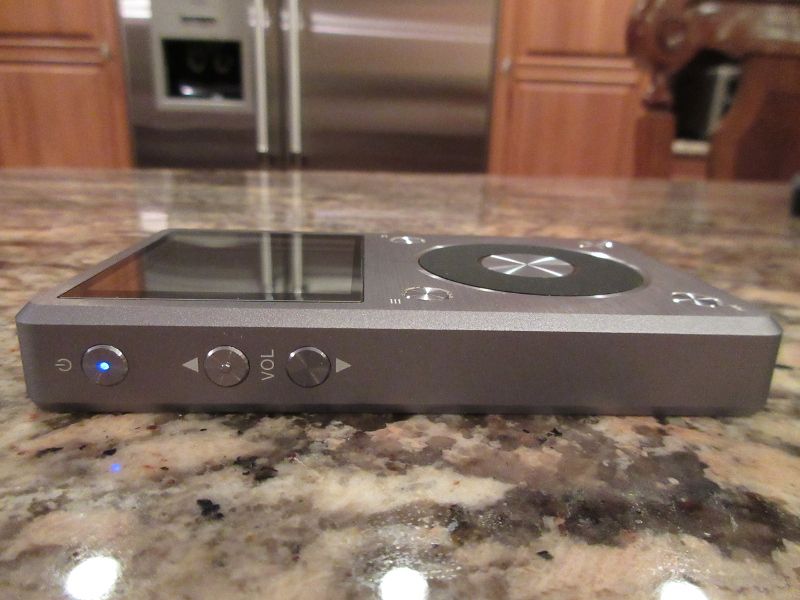
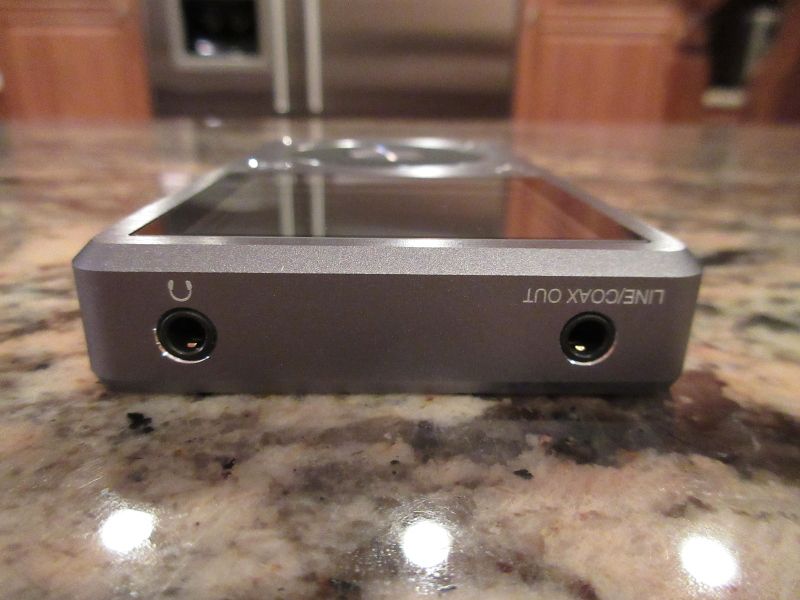
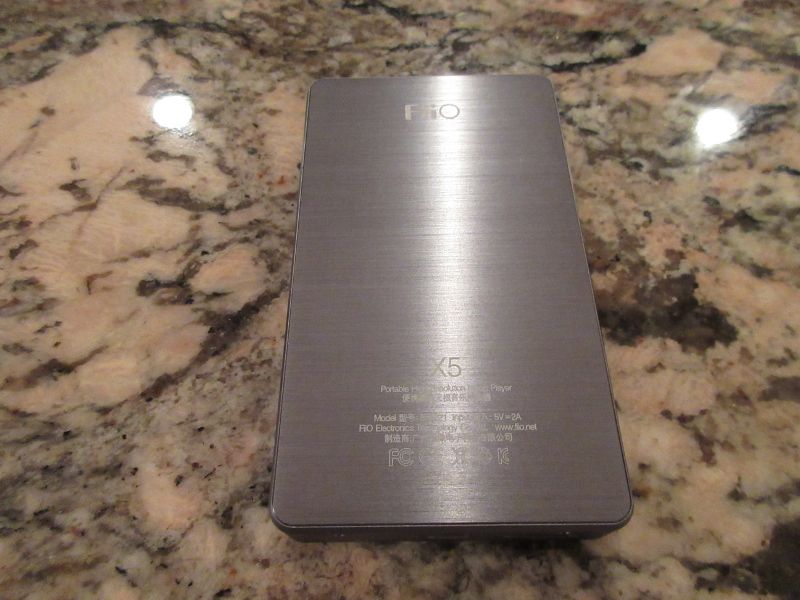
Though exterior changes are the most obvious differences when you first look at the new X5ii, the 2nd gen update included a lot of substantial internal design changes and improvement as well. Probably the first and the most noteworthy change come from a new redesigned amplification stage and analog volume control. To my ears the improvement was noticeable enough and I will talk more about it in sound test section of the review. Another change had to do with all new digital audio architecture with a dedicated dual crystal oscillator covering all major rates. Using multiples of common clock rates to derive other rates ensures a reduced jitter performance. I was also glad to see implementation of hardware DSD decoding with a native DSD support without a need for internal PCM conversion - another noticeable improvement when playing hi-res lossless files. Of course, X5ii still supports almost every available lossy and lossless format under the sun, everything from DSD64/128 to 24bit/192kHz in FLAC, APE, ALAC, WAV, AIFF, WMA, and other formats such as MP3, AAC, OGG, etc.
Native DSD support was introduced in X3ii already, the same way how the introduction of in-line remote control support got carried over from X3ii to X5ii. Don't expect volume control on in-line remote to work, but a single click Play/Pause and multi-click track skip worked flawlessly with a lot of my headphones. It's true that a lot of audiophiles prefer audio-only cable, but when you are on the go and want a simple remote control without reaching for your DAP or fumbling in your pocket - support of in-line control is extremely valuable. Another improvement carried over from X3ii was a new power management with a deep-sleep standby and instant-on resume - an absolute life safer when you take periodic breaks from listening and don't want to restart your DAP if it shuts down after time out.
Btw, this deep sleep is not a gimmick. I tested it on a number of occasions and was always amazed by how little battery was drained while in this standby mode. Even when you are playing the music, battery life was still impressive with playback of about 10-11 hrs depending on the gain level and the volume level. FiiO also mentioned about implementation of Coulomb meter for precise battery level readout. I just hope that at some point they will implement the actual % of battery display in notification bar as well. This 10-11 hrs battery endurance was accumulated across various tests where most of the time screen ended up being off - a typical real life usage. With a screen on the time will be reduced a little, though it's hard to quantify it since it all depends on your usage. And speaking of a screen, the rich color saturated display of X5ii is among the best out of the entire FiiO lineup, and it was an absolute pleasure to use it indoors and outdoors with a clear and crisp visibility of menus and full album cover art, actually a big step up from X3ii display.
Since I mentioned about a display, I think now it's a good time to dive more into FiiO’s updated GUI. Actually those who are intimately familiar with X1 and X3ii, X5ii GUI layout will be seen more like a dot update. With a clear semi-circle left to right menu layout, it was updated with an improved graphics details and more features added under setting and playback menus.
The main screen presents you with 5 selections of Now Playing (defaults to a currently playing track), Play by Category (with a choice of All songs, Album, Artist, Genre, Collection of Favorites - tagged from song playback, and Playlists selection), Browse Files (my favorite selection to view files by folders in Card 1, Card 2, and OTG connection - as long as you have FAT32 formatted device, you can expand your storage capacity by connecting external memory through usb OTG adapter), Play Setting, and System Setting. As you can see, there are plenty of choices for music browsing and playback, and navigation is super easy with a scrolling wheel. Once you select a song and it starts playing, the playback screen will display song/album art, if available, and you will see a current time marker for the song and the total time, the title of the song and the artist, and briefly a display with info about the file type.
In the notification bar you can always see a volume level with corresponding value, Gain setting (L or H), EQ selection, a number of populated micro-sd cards, Playback status (plays/pause), and a battery status. During the playback you can skip a song using two control buttons at the bottom or just by scrolling a wheel which brings you to a folder list where you click Play to select another song. Pressing and holding skip song buttons will fast fwd/rev through a song, while a middle button works as Play/Pause, unless you press'n'hold it to get into volume control using a scrolling wheel. Upper right button works as "go back" and upper left button brings up an icon menu where you can add a song to a favorite list or to a specific playlist, to delete a song, or to select different playback modes (loop, through, crossfade, and repeat one). All this is extremely convenient for one handed operation.
Going back to Play settings, you have a very comprehensive list of options related to playback. You can change Play mode (similar to accessing playback modes), enable Resume mode, Gapless playback, cap the max volume level, set power-on volume and associated fixed volume setting, select between Low and High gain, enter EQ screen (10-band EQ with a custom setting and a lot of genre specific presets), L/R Balance setting, and a new option of Play through Folders setting.
System settings gives you an option of language selection, Media Library update, Key-lock settings (with different options for lockscreen controls when display is off), Screen timeout, Brightness setting, Idle standby and corresponding timer, Sleep on/off and corresponding timer, Selection of shared output as either Line Out of Coax, File name display (as either Title or the actual file name), USB mode (DAC or Storage), enabling support of in-line headphone controls, display theme selection (5 unique choices), About X5 inf (which gives you both cards total capacity and available capacity, total number of songs, firmware version and serial number, and entire digital copy of detailed Quick Start Guide), Format (important if you are having problem with FAT32 format of your flash card), and last but not least - Reset to factory defaults.
I already mentioned about in-line remote control, and just want to talk briefly about USB mode. Storage selection enables you to connect X5ii to your computer where you can update the content of the flash cards by a simple drag’n’drop. But with USD DAC selection you turn X5ii into an external usb soundcard. After installation of proper drivers, X5ii is recognized as usb audio output to stream audio from your computer. Though I personally prefer a dedicated USB DAC and feel like using DAP for this functionality is overkill, it was still nice to be able to improve sound quality (more detailed clean sound) of my ThinkPad laptop with a help of X5ii. In this configuration while using DAP as usb DAC you are also charging it in parallel through usb port so you don't have to worry about drain a battery. Furthermore, you can use Play/Pause and change volume right from X5ii remotely - very convenient for an external audio interface. Just remember, you are not changing volume level on your computer, just relative to X5ii playback.
With a consistent flow of new releases, I feel like we have been spoiled by FiiO and their quality audio products. I didn’t even realize it has been year and a half since the release of their original X5, and now I’m looking at their new X5ii flagship DAP released a few months after another impressive X3ii DAP update. What strikes me the most, FiiO continues to update a number of their previously released models (DAPs and amps) while keeping price in the same ballpark. And I’m not talking about a cosmetic refresh or a firmware update but actually a complete redesign. Perhaps it’s the way how they challenge themselves, trying to come up with a creative update without raising the cost. In my opinion, they do succeed every single time, with their latest X5ii being another perfect example of it!
At the same time this high pace of new releases sometime feels like smartphone industry where every six months to a year we are faced with choices to either stay with a current phone or to upgrade, and if you decide to upgrade - either going with a smaller or bigger screen model. I think a lot of FiiO fans will be facing a similar choice, either keeping their original X5 or upgrading to a “smaller” X3ii or a “bigger” X5ii, figuratively speaking. If you want the latest and the greatest new release, a decision is simple - go with X5ii without looking back. But for other loyal FiiO fans or new customers who are looking into different DAPs, I hope my review will provide some useful guidance to make your decision easier. FiiO is very active and generous in various audiophile communities, such as Head-fi, where a lot of reviews and impressions have been posted already. With my write up I hope to fill in some gaps and to offer a different perspective to compliment other available info.
Though the unit I received is pre-production review sample, the content of the packaging should be close to the final product which I'm sure will include a colorful outer sleeve on top of the box my unit came in. Keeping up with a tradition, X5ii arrived in a formally dressed black gift box setting with a nicely padded interior to ensure a secure transport of its content. I personally like such gift-box detail, actually adapted by a number of manufacturers, since it makes unboxing experience a little more special and a sturdy carton box is also a great storage.
Unboxing.



Already dressed in silicone skin and ready for action, after removing X5ii from a cutout of the foam insert tray, I accessed the accessories box and was able to explore the rest of the included goodies. No surprises were found here, just a familiar set of accessories consistent with their other models. You get a quick start guide and a separate flash card with a layout and explanation of hardware controls, extra 2 sets of screen protector in addition to the one which comes already pre-installed, a cover stickers for the front/back/sides if you decide to personalize your DAP further (includes US flag, wood, and carbon fiber themes), usb to micro-usb power/data cable, and a short Coax patch cable. I think a final production unit will also feature a flash card reader.
While a carbon fiber sticker doesn't look too bad, I’m not so sure about other two themes and would suggest in a future to include something alternative for the ladies. Brushed aluminum and carbon fiber finish is great for guys, but I would like to see FiiO making an effort to widen their sex appeal. Actually in my personal opinion, the brushed aluminum body finish is too cool to cover with anything permanent, except with an included silicone case. Screen protector is always a good idea to protect X5's gorgeous 2.4" HD IPS screen from scratches and smudges. As for usb cable, FiiO usually includes a quality one which also guarantees a fast 2A charging with an appropriate supply. The micro-usb connector is slim and has a nice lock grip, just another detail I want to bring up since with a few of my other usb charging cables I had to take silicone skin off in order to get a proper fit/connection. Coax cable is different from the original X5 since in X5ii LO and Coax 3.5mm ports are shared, thus you will find extra ring-contacts (TRRS style) on 3.5mm connector side.
Accessories.




I usually don't spend too much time talking about silicone case, but still wanted to bring up a few important points. There is no surprise, silicone case gets static and becomes a lint magnet, but I still prefer it over any slippery plastic case because I like a secure grip. Another benefit, it protects your DAP from scratches and minor drops, creates extra friction when placed on a smooth surface, protects outside surface itself from scratches, and protects the shell from scratches when stacked with external amp rubber-banded together. The case has a perfect cutout for screen and navigation wheel, micro-usb port, a flap over LO/Coax port, and open HO port.
HO port opening is very useful in this case because FiiO flipped HO and LO ports in comparison to their other DAPs where left-most port used to be always for Headphone Output. We are creates of habit, and without a case and both ports exposed there is a very good chance that you will make an attempt to plug in your headphones into LO port to get a very unpleasant ear-full surprise, especially if you are a/b it with original X5 or X3ii. So even if you prefer to go naked without a case, use it for the first few weeks as training wheels until you get used to HO port being on the right side at the top.
Another interesting discovery I made even before turning the power on was a hole right in the middle of the power button cover. In this new X5ii model FiiO integrated a status multi-color LED right inside of the power button thus an explanation for a small opening in the case to view the light. Volume up button on a silicone case, just like with an actual DAP button, has a little id bump so you can identify volume+ control blindly in your pocket with a brush of a finger. Power button itself is flush mounted to avoid accidental pressing. The other 4 control buttons around navigation wheel are flush mounted as well and also nearly flat on the silicone case. It's useful if you have selected Lockscreen option that enables their control for track switching, and you no longer have to worry about accidentally pressing buttons in your pocket the way how it was with raised buttons in original X5. But at the same time, I would prefer buttons to be raised just a little bit like it was in X3ii which is the most ideal in my opinion.
Silicone case.



When it comes to the actual design, in my opinion X5ii is definitely a step forward in terms of a more compact footprint in comparison to the original X5. While keeping the thickness nearly the same, the length and the width got trimmed down and weight got reduced by nearly 30g. Similar to X3ii design, top of the unit has 3.5mm Headphone Output (HO) and a shared Line Out (LO) and Coax outputs. There is nothing on the right side, and left side is consistent with a top Power button (already discussed with a built-in status led) and volume up/down buttons. No longer will you find a reset pinhole, just need to press and hold power button for the same functionality. Consistent with the original X5 design, the bottom has 2 micro-SD card slots and micro-usb connector. You are also going to find 2 screws at the bottom if you dare to take X5ii apart, though be aware of voided warranty.
You will no longer find a dust cover rubber flaps over micro-SD slots similar to the original X5. If you carry your X5ii in a silicone case, it really doesn't matter since it will be covered and protected from dust already. I also believe it's not a big deal without a case with a card inside, like it is with any other DAP. But considering dual card slot and if you are not using a case and only have one card populated - it's not ideal for the other slot to be open while collecting the dust. Perhaps, get some dummy or super cheap micro-sd card from ebay just to use for the purpose of keeping a dust away.
The front of X5ii has 2.4" HD IPS screen at the top and a scrolling wheel with 4 control buttons around it and one button in the middle, a familiar layout carried over through all of the X-models (after the original X3). I know a lot of people will be curious about a scrolling wheel "evolution" since FiiO has been consistent with improvements from X5 to X1 and X3ii. Unfortunately, my review unit came from a first pre-production batch where FiiO made it clear this is not a final wheel version. It wasn't as wobbly as X5 wheel, but still had a loose movement without a click-feedback like implemented in X3ii. FiiO mentioned that final production units will have a scrolling wheel similar to X3ii which has been already confirmed by some users who got their hands on final production units. When it comes to my actual review unit, I wasn't as pleased with a wheel due to a light-touch turning by simply brushing against it. Unfortunately that happened a lot because control buttons were flushed with a surface and I had to hover over a surface with my finger to locate them. Even with a scrolling wheel mechanism such as the one used in X3ii, I personally think the layout of these buttons pushed away a little more from the wheel and the flush mounted design is a step back from X3ii where it was just perfect for one handed operation. X5ii is still feasible to use with one hand, but I just wish the beveled area and buttons around the wheel were similar to X3ii. Either way, if I get a chance to play with final production unit, I will come back and update my scrolling wheel impression.
Design details.






Though exterior changes are the most obvious differences when you first look at the new X5ii, the 2nd gen update included a lot of substantial internal design changes and improvement as well. Probably the first and the most noteworthy change come from a new redesigned amplification stage and analog volume control. To my ears the improvement was noticeable enough and I will talk more about it in sound test section of the review. Another change had to do with all new digital audio architecture with a dedicated dual crystal oscillator covering all major rates. Using multiples of common clock rates to derive other rates ensures a reduced jitter performance. I was also glad to see implementation of hardware DSD decoding with a native DSD support without a need for internal PCM conversion - another noticeable improvement when playing hi-res lossless files. Of course, X5ii still supports almost every available lossy and lossless format under the sun, everything from DSD64/128 to 24bit/192kHz in FLAC, APE, ALAC, WAV, AIFF, WMA, and other formats such as MP3, AAC, OGG, etc.
Native DSD support was introduced in X3ii already, the same way how the introduction of in-line remote control support got carried over from X3ii to X5ii. Don't expect volume control on in-line remote to work, but a single click Play/Pause and multi-click track skip worked flawlessly with a lot of my headphones. It's true that a lot of audiophiles prefer audio-only cable, but when you are on the go and want a simple remote control without reaching for your DAP or fumbling in your pocket - support of in-line control is extremely valuable. Another improvement carried over from X3ii was a new power management with a deep-sleep standby and instant-on resume - an absolute life safer when you take periodic breaks from listening and don't want to restart your DAP if it shuts down after time out.
Btw, this deep sleep is not a gimmick. I tested it on a number of occasions and was always amazed by how little battery was drained while in this standby mode. Even when you are playing the music, battery life was still impressive with playback of about 10-11 hrs depending on the gain level and the volume level. FiiO also mentioned about implementation of Coulomb meter for precise battery level readout. I just hope that at some point they will implement the actual % of battery display in notification bar as well. This 10-11 hrs battery endurance was accumulated across various tests where most of the time screen ended up being off - a typical real life usage. With a screen on the time will be reduced a little, though it's hard to quantify it since it all depends on your usage. And speaking of a screen, the rich color saturated display of X5ii is among the best out of the entire FiiO lineup, and it was an absolute pleasure to use it indoors and outdoors with a clear and crisp visibility of menus and full album cover art, actually a big step up from X3ii display.
Since I mentioned about a display, I think now it's a good time to dive more into FiiO’s updated GUI. Actually those who are intimately familiar with X1 and X3ii, X5ii GUI layout will be seen more like a dot update. With a clear semi-circle left to right menu layout, it was updated with an improved graphics details and more features added under setting and playback menus.
The main screen presents you with 5 selections of Now Playing (defaults to a currently playing track), Play by Category (with a choice of All songs, Album, Artist, Genre, Collection of Favorites - tagged from song playback, and Playlists selection), Browse Files (my favorite selection to view files by folders in Card 1, Card 2, and OTG connection - as long as you have FAT32 formatted device, you can expand your storage capacity by connecting external memory through usb OTG adapter), Play Setting, and System Setting. As you can see, there are plenty of choices for music browsing and playback, and navigation is super easy with a scrolling wheel. Once you select a song and it starts playing, the playback screen will display song/album art, if available, and you will see a current time marker for the song and the total time, the title of the song and the artist, and briefly a display with info about the file type.
In the notification bar you can always see a volume level with corresponding value, Gain setting (L or H), EQ selection, a number of populated micro-sd cards, Playback status (plays/pause), and a battery status. During the playback you can skip a song using two control buttons at the bottom or just by scrolling a wheel which brings you to a folder list where you click Play to select another song. Pressing and holding skip song buttons will fast fwd/rev through a song, while a middle button works as Play/Pause, unless you press'n'hold it to get into volume control using a scrolling wheel. Upper right button works as "go back" and upper left button brings up an icon menu where you can add a song to a favorite list or to a specific playlist, to delete a song, or to select different playback modes (loop, through, crossfade, and repeat one). All this is extremely convenient for one handed operation.
Going back to Play settings, you have a very comprehensive list of options related to playback. You can change Play mode (similar to accessing playback modes), enable Resume mode, Gapless playback, cap the max volume level, set power-on volume and associated fixed volume setting, select between Low and High gain, enter EQ screen (10-band EQ with a custom setting and a lot of genre specific presets), L/R Balance setting, and a new option of Play through Folders setting.
System settings gives you an option of language selection, Media Library update, Key-lock settings (with different options for lockscreen controls when display is off), Screen timeout, Brightness setting, Idle standby and corresponding timer, Sleep on/off and corresponding timer, Selection of shared output as either Line Out of Coax, File name display (as either Title or the actual file name), USB mode (DAC or Storage), enabling support of in-line headphone controls, display theme selection (5 unique choices), About X5 inf (which gives you both cards total capacity and available capacity, total number of songs, firmware version and serial number, and entire digital copy of detailed Quick Start Guide), Format (important if you are having problem with FAT32 format of your flash card), and last but not least - Reset to factory defaults.
I already mentioned about in-line remote control, and just want to talk briefly about USB mode. Storage selection enables you to connect X5ii to your computer where you can update the content of the flash cards by a simple drag’n’drop. But with USD DAC selection you turn X5ii into an external usb soundcard. After installation of proper drivers, X5ii is recognized as usb audio output to stream audio from your computer. Though I personally prefer a dedicated USB DAC and feel like using DAP for this functionality is overkill, it was still nice to be able to improve sound quality (more detailed clean sound) of my ThinkPad laptop with a help of X5ii. In this configuration while using DAP as usb DAC you are also charging it in parallel through usb port so you don't have to worry about drain a battery. Furthermore, you can use Play/Pause and change volume right from X5ii remotely - very convenient for an external audio interface. Just remember, you are not changing volume level on your computer, just relative to X5ii playback.

